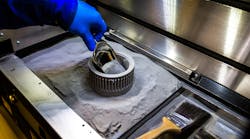Innovation in process manufacturing technologies hasn’t been hampered by creativity or design: The engineering minds that dreamed up wireless monitoring and rich analytics software are always churning out new ideas. Instead, innovation has been hamstrung by the age-old question: How can we make this concept come to life? Traditional manufacturing processes and speed to market are considerations that can be difficult to overcome.
Additive manufacturing is poised to address those challenges and become a game-changer for industries that serve as the backbone of daily life. The term “additive manufacturing” describes the technology that builds three-dimensional objects by adding material like titanium and steel in a powder form, layer by layer, from digital model designs. Better known as 3D printing, additive manufacturing is dissolving the constraints of traditional manufacturing methods and instead bringing game-changing technologies to consumers faster than ever.
Now, through additive manufacturing, a new design can be printed directly from a CAD file. In the smart factories of the future, there will not only be rigid production lines popping out standard parts at lightning-fast speeds, but also fully automated additive production lines that flexibly produce one-of-a-kind special pieces and low-volume parts to meet specific customer needs.
While 3D printing is a hot trend that can sometimes feel gimmicky, additive manufacturing is quickly proving its worth within process industries.
For example, cavitation—getting entrained within a fluid—is a significant problem across industries, disrupting flow performance and sometimes leading to equipment damage. For rotary style control valves the industry has addressed the issue through a dampening product, created by manually welding steel tubes or plates together. Because additive manufacturing significantly accelerates the testing of multiple versions of a prototype product or part, it promises to greatly simplify the production supply chain – helping us make strong solutions even better. Through additive technology, a new rotary product called the Fisher™ Cavitrol™ Hex trim features hexagon-shaped tubes that address cavitation by providing better fluid-handling properties and better reliability—an advancement that would have been impossible with traditional manufacturing methods.
Additive manufacturing will help when there is a need to make low-volume special components, as well as a new generation of high-performance parts that cannot be made any other way, because of the ability to reduce complex shapes to simple 2D slices. This method will free the industry from having to build a whole production line with molds and fixtures for a customer’s specific part. This manufacturing flexibility, coupled with the design freedom already available in computer-aided design software, will spark the next generation of high-performance parts that drive greater efficiency and performance and enable companies to design products more tailored to a customer’s specific need.
These design functions are just the beginning. Additive manufacturing makes it possible to put material exactly where it needs to be to reduce part weight, improve flow paths and increase the complexity of parts, even pulling in new materials for a bigger impact. Many process flow applications benefit from super-hard alloys with great wear resistance, but these alloys can be challenging for traditional manufacturing because the same properties that make them great in the field can make them almost impossible to machine. However, when a part can be printed to near net within a few thousandths of an inch, additive manufacturing can do a lot more with these exciting alloys.
By removing many traditional limits, additive manufacturing is quickly reshaping design and production of critical industrial equipment. These examples are just the tip of the iceberg for additive manufacturing—an industry-transforming technology that is just getting started.
Sponsored by:





